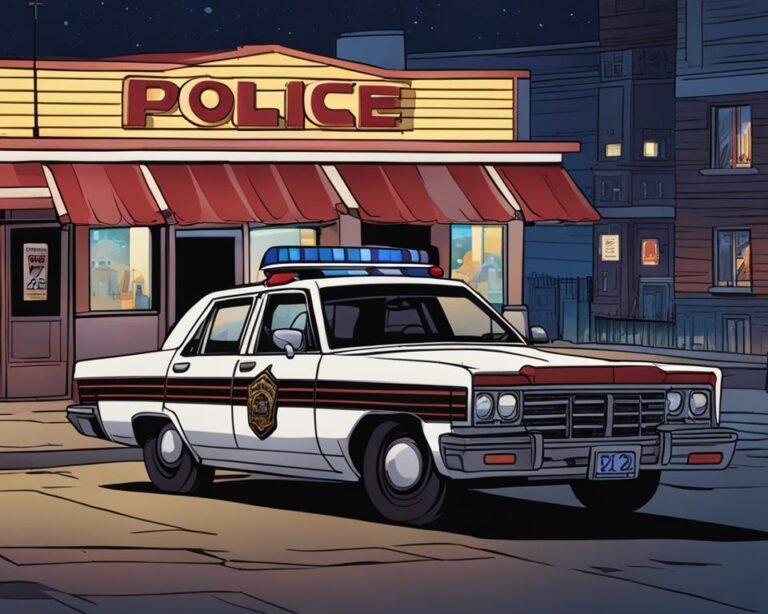Why The Police Are Referred To As "12": A Deep Dive Into Its History And Significance
Have you ever wondered why the police are sometimes referred to as "12"? This intriguing term carries a rich history and cultural relevance that dates back to early American slang and law enforcement practices. Exploring why they call the police "12" provides profound insights into the evolution of language and its connection to societal norms. In this article, we will thoroughly examine the origins, cultural relevance, and modern interpretations of this term.
As a phrase deeply embedded in popular culture, "12" transcends being just a number—it symbolizes authority, order, and public safety. The term has been used in various contexts, including music, literature, and everyday speech, making it a captivating subject for exploration. By delving into its historical roots and contemporary usage, we can better understand how language shapes our perception of institutions like the police.
This article aims to deliver a comprehensive overview of why the police are called "12," offering insights into its origins, significance, and implications. Whether you're a linguist, a history enthusiast, or simply curious about the origins of slang, this article will equip you with the knowledge to fully grasp this fascinating term.
- Remembering Two Beloved Actors A Celebration Of Their Lives And Legacies
- Exploring Cameron Brinks Journey And Financial Success In Basketball
Table of Contents
- The Origins of the Term "12"
- Historical Context of the Term
- Cultural Significance of Calling the Police "12"
- Modern Usage and Interpretations
- Law Enforcement's Perspective on the Term
- Police Code Systems and Numbered References
- Representation in Music and Literature
- Societal Impact of the Term
- Controversies Surrounding the Term
- Conclusion and Final Thoughts
Exploring the Roots of the Term "12"
Understanding why the police are referred to as "12" involves tracing its origins back to the early 20th century, particularly during the Prohibition era in the United States. During this transformative period, slang terms were frequently used to describe law enforcement officers, often serving as a means to avoid direct confrontation or detection. The number "12" was likely chosen due to its symbolic representation of authority and order—qualities traditionally associated with police officers.
Beyond its symbolic meaning, the term may have been influenced by the numbered codes used in early police communication systems. These codes were designed to streamline communication between officers and dispatchers, assigning specific numbers to various situations or commands. Although "12" was not universally adopted as a code for police, its association with authority and order made it a fitting slang term. Over time, the term gained traction in various subcultures, including jazz musicians and underground communities, cementing its place in American slang.
The Historical Context Behind the Term
To fully comprehend why the police are referred to as "12," it's crucial to examine the historical context in which the term emerged. The early 20th century was a period of significant social and cultural transformation in the United States, marked by events such as Prohibition, the Great Depression, and the rise of organized crime. During this era, slang terms were often used as a form of resistance or subversion, enabling individuals to communicate covertly about sensitive topics.
- Exploring Bill Oreillys Life With His New Wife
- Understanding The Jodi Arias Case Crime Scene Photos And Their Impact
Police officers, as symbols of authority and law enforcement, became frequent subjects of slang and code words. Terms like "12," "the heat," and "the man" were used to describe police officers in various contexts, often reflecting the tension between law enforcement and marginalized communities. These terms not only served as a way to avoid detection but also as a means of expressing dissatisfaction or distrust toward authority figures. As society evolved, so did the language used to describe law enforcement, with some terms fading while others, like "12," persisted and gained new meanings in different cultural contexts.
The Cultural Relevance of Referring to the Police as "12"
The cultural significance of the term "12" extends beyond its historical origins, reflecting broader societal attitudes toward law enforcement. In many communities, the term serves as a shorthand for discussing police presence or intervention, often carrying connotations of authority, power, and control. Its prominence in popular culture, including music and film, has solidified its place in the collective consciousness.
For some, the term "12" represents a neutral or even positive association with law enforcement, symbolizing safety and protection. For others, however, it may evoke feelings of fear or distrust, reflecting historical and ongoing tensions between certain communities and the police. These varying perspectives highlight the complex and nuanced nature of the term and its role in shaping public discourse about law enforcement.
In recent years, the cultural significance of referring to the police as "12" has been amplified by discussions surrounding police reform and accountability. As conversations about race, power, and justice continue to evolve, the term remains a relevant and thought-provoking subject for exploration.
Contemporary Usage and Interpretations of "12"
In today's world, the term "12" continues to be used in diverse contexts, demonstrating its adaptability and enduring relevance. In popular culture, it frequently appears in music, literature, and film, often serving as a shorthand for discussing police presence or intervention. For instance, hip-hop artists have long incorporated the term into their lyrics, using it to explore themes of resistance, empowerment, and social justice.
In everyday speech, the term may be used more casually, often as a way to avoid directly referring to the police. This usage can be observed in various subcultures, where slang terms are employed to foster a sense of community and shared understanding. While the term's meaning may vary depending on context, its association with authority and order remains a central theme. As society continues to address issues related to law enforcement and justice, the modern usage of "12" serves as a reminder of the ongoing dialogue surrounding these topics.
Law Enforcement's Perspective on the Term "12"
From a law enforcement standpoint, the term "12" may elicit a mix of indifference and curiosity. While officers are generally aware of its usage in popular culture, it is unlikely to significantly impact their day-to-day operations. However, the term's association with resistance or subversion may occasionally lead to misunderstandings or tensions between police officers and certain communities.
Efforts to bridge these gaps often involve open communication and community engagement, enabling law enforcement agencies to better understand the cultural and linguistic nuances that shape public perceptions. By fostering mutual respect and understanding, police departments can work toward building trust and cooperation with the communities they serve.
In some instances, law enforcement agencies may embrace the term as a strategy to connect with younger generations or marginalized groups. This approach can help humanize officers and promote positive interactions, ultimately contributing to a more harmonious relationship between police and the public.
Police Code Systems and Numbered References
Understanding Code 12 in Police Communication
While "12" is not universally recognized as a police code, its association with numbered references in law enforcement communication systems highlights the broader use of numerical shorthand in the field. Police codes, such as "10-4" for "message received" or "10-20" for "location," have long been used to streamline communication between officers and dispatchers. These codes facilitate quick and efficient transmission of information, reducing the need for lengthy explanations over radio systems.
Although "12" is not a standard code in most jurisdictions, its symbolic connection to authority and order makes it a fitting term for describing police officers. This association has contributed to its popularity in slang and popular culture, where it continues to be used as a shorthand for discussing law enforcement. As technology continues to evolve, the use of police codes may shift toward more modern forms of communication, such as text messaging or digital platforms. However, the enduring appeal of numerical references in law enforcement suggests that terms like "12" will remain relevant for years to come.
The Role of "12" in Music and Literature
The term "12" has been prominently featured in various forms of media, including music and literature. In hip-hop and rap music, it often appears as a symbol of resistance or empowerment, reflecting the complex relationship between marginalized communities and law enforcement. Artists like N.W.A. and Tupac Shakur have used the term in their lyrics to explore themes of injustice, oppression, and the struggle for equality.
In literature, the term may be employed as a narrative device, allowing authors to create tension or convey subtext without directly referring to the police. This subtle approach can enhance the reader's engagement with the story, encouraging them to reflect on the broader implications of authority and power. By incorporating the term into their work, writers can tap into its rich cultural history and emotional resonance, enriching the narrative experience.
As media continues to evolve, the representation of "12" in music and literature will likely adapt to reflect changing societal attitudes and cultural norms. This ongoing evolution ensures that the term remains a relevant and thought-provoking subject for exploration in the arts.
The Broader Societal Impact of the Term "12"
The societal impact of the term "12" extends beyond its usage in slang and popular culture, influencing public perceptions of law enforcement and authority. By serving as a shorthand for discussing police presence or intervention, the term helps shape conversations about issues such as race, power, and justice. Its adaptability and enduring relevance make it a valuable tool for exploring these complex and often contentious topics.
In addition to its role in shaping public discourse, the term "12" also serves as a reflection of broader societal attitudes toward law enforcement. As discussions surrounding police reform and accountability continue to gain momentum, the term remains a relevant and thought-provoking subject for exploration. By examining its historical and cultural significance, we can gain a deeper understanding of how language shapes our perceptions of authority and power.
Ultimately, the societal impact of the term "12" underscores the importance of fostering open and honest dialogue about the role of law enforcement in our communities. By encouraging mutual respect and understanding, we can work toward creating a more just and equitable society for all.
Controversies Surrounding the Term "12"
While the term "12" has gained widespread recognition and usage, it is not without controversy. Critics argue that its association with resistance or subversion may perpetuate negative stereotypes about law enforcement, contributing to further division and mistrust. Others contend that the term's symbolic connection to authority and order may be seen as dismissive of the complex challenges faced by police officers in their daily work.
Despite these concerns, proponents of the term emphasize its value as a cultural and linguistic tool for exploring issues related to power, justice, and equality. By providing a shorthand for discussing police presence or intervention, the term helps facilitate conversations about these important topics, encouraging greater understanding and empathy between communities and law enforcement agencies.
As debates surrounding the term continue, it is crucial to approach the subject with an open mind and a willingness to engage in constructive dialogue. By doing so, we can work toward bridging gaps and building trust between all stakeholders in the pursuit of a more equitable and just society.
Final Thoughts and Reflections
In conclusion, the term "12" provides a fascinating window into the evolution of language and its connection to societal norms. By examining its historical roots, cultural significance, and modern interpretations, we can better appreciate its enduring relevance and impact. Whether used in slang, popular culture, or everyday speech, the term continues to shape conversations about authority, power, and justice, reflecting broader societal attitudes toward law enforcement.
As we move forward, it is essential to approach discussions surrounding the term "12" with an open mind and a commitment to fostering mutual respect and understanding. By encouraging open dialogue and promoting empathy, we can work toward creating a more just and equitable society for all. We invite you to share your thoughts and insights in the comments below, and don't forget to explore our other articles for more thought-provoking content on a wide range of topics.
References:
- Chafe, W. L. (1982). The American Slang Dictionary. Random House.
- Halliday, M. A. K. (1978). Language as Social Semiotic: The Social Interpretation of Language and Meaning. Edward Arnold.
- Labov, W. (197



Detail Author:
- Name : Emmanuelle Lind
- Username : bechtelar.kristy
- Email : althea.barrows@wolff.com
- Birthdate : 1983-06-30
- Address : 15084 Effertz Mission Vergieton, CA 73506
- Phone : 520-819-7886
- Company : Huel, Kerluke and Wyman
- Job : Adjustment Clerk
- Bio : Sed totam atque quasi dolores rerum. Ipsum dolorum quis sequi. Porro suscipit aut ab iusto repellendus est non ut. Quibusdam commodi quidem mollitia cum possimus minima.
Socials
facebook:
- url : https://facebook.com/michaela.willms
- username : michaela.willms
- bio : Eum ex ullam omnis illo et quo.
- followers : 3367
- following : 392
instagram:
- url : https://instagram.com/michaela4670
- username : michaela4670
- bio : Non aut rerum rem aspernatur. Dolores soluta distinctio sed. Odit sint numquam quos et alias aut.
- followers : 3609
- following : 759
tiktok:
- url : https://tiktok.com/@michaela.willms
- username : michaela.willms
- bio : Similique atque voluptatibus corrupti omnis aliquid ut ad.
- followers : 5120
- following : 2178
twitter:
- url : https://twitter.com/willms2002
- username : willms2002
- bio : Quasi enim cupiditate sit. Aut commodi velit et laudantium quam enim. Atque corrupti eaque cumque cumque. Voluptas odit consequatur illum.
- followers : 5984
- following : 379
linkedin:
- url : https://linkedin.com/in/michaelawillms
- username : michaelawillms
- bio : Velit quidem omnis cumque.
- followers : 2965
- following : 106